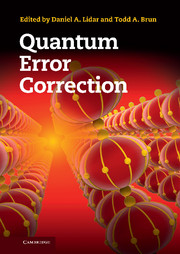Book contents
- Frontmatter
- Contents
- List of contributors
- Prologue
- Preface and guide to the reader
- Acknowledgements
- Part I Background
- Part II Generalized approaches to quantum error correction
- Part III Advanced quantum codes
- Part IV Advanced dynamical decoupling
- 14 High-order dynamical decoupling
- 15 Combinatorial approaches to dynamical decoupling
- Part V Alternative quantum computation approaches
- Part VI Topological methods
- Part VII Applications and implementations
- Part VIII Critical evaluation of fault tolerance
- References
- Index
15 - Combinatorial approaches to dynamical decoupling
from Part IV - Advanced dynamical decoupling
Published online by Cambridge University Press: 05 September 2013
- Frontmatter
- Contents
- List of contributors
- Prologue
- Preface and guide to the reader
- Acknowledgements
- Part I Background
- Part II Generalized approaches to quantum error correction
- Part III Advanced quantum codes
- Part IV Advanced dynamical decoupling
- 14 High-order dynamical decoupling
- 15 Combinatorial approaches to dynamical decoupling
- Part V Alternative quantum computation approaches
- Part VI Topological methods
- Part VII Applications and implementations
- Part VIII Critical evaluation of fault tolerance
- References
- Index
Summary
Introduction
In this chapter we continue the introduction to dynamical decoupling techniques for open quantum systems that was started in Chapter 4. Here we focus on the construction of efficient schemes for dynamical decoupling and we highlight some combinatorial constructions. Efficiency of decoupling schemes is measured in terms of the number of control operations to be applied to the system. This number should be small, ideally a polynomial in the number of qubits in the system.
If we assume that the quantum system is governed by a general Hamiltonian HS, having interactions involving any subset of the qubits, then any scheme that achieves decoupling of HS is necessarily inefficient in the above sense. The efficient schemes we consider here arise in physically realistic situations where there are much more stringent restrictions on the types of interactions. The most important example is the case of pair-interaction Hamiltonians. These Hamiltonians can be expressed as sums of interaction terms that involve at most two qubits.
While there is a large body of work on dynamical decoupling schemes for pair-interaction Hamiltonians [S90, EBW94,WHH68, H76], which historically has been used mainly in the context of nuclear magnetic resonance (NMR) theory, the past few years have seen a development of new techniques for decoupling that are based on group theory. We therefore call such techniques, or rather the pulse sequences that an experimenter can apply to a given Hamiltonian in order to selectively switch off unwanted couplings, combinatorial decoupling schemes.
Information
- Type
- Chapter
- Information
- Quantum Error Correction , pp. 376 - 394Publisher: Cambridge University PressPrint publication year: 2013
Accessibility standard: Unknown
Why this information is here
This section outlines the accessibility features of this content - including support for screen readers, full keyboard navigation and high-contrast display options. This may not be relevant for you.Accessibility Information
- 1
- Cited by
